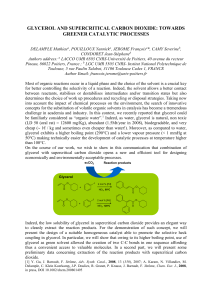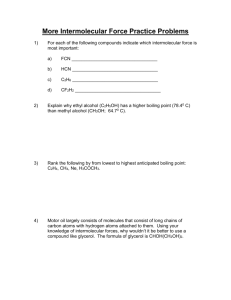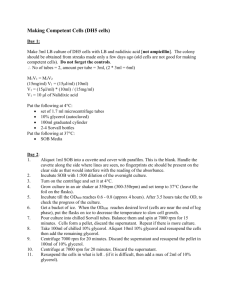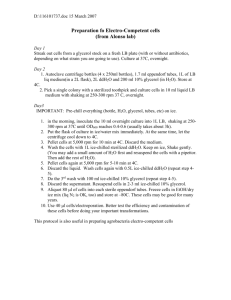Viscosity of Cetrimide in Glycerol and Water
advertisement
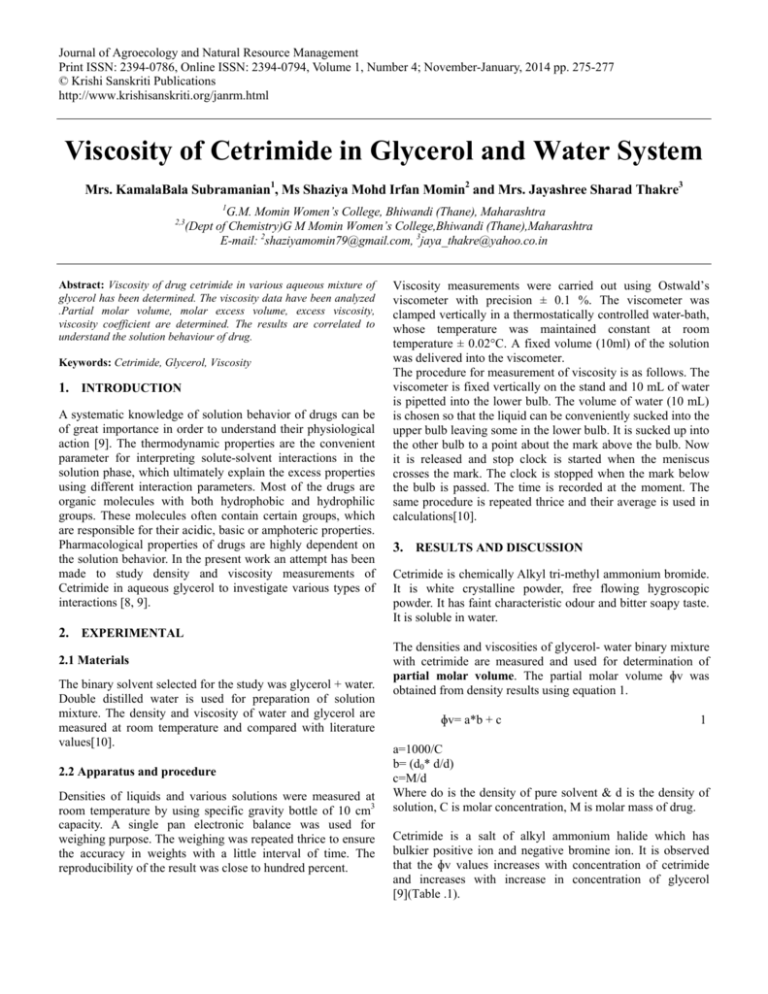
Journal of Agroecology and Natural Resource Management Print ISSN: 2394-0786, Online ISSN: 2394-0794, Volume 1, Number 4; November-January, 2014 pp. 275-277 © Krishi Sanskriti Publications http://www.krishisanskriti.org/janrm.html Viscosity of Cetrimide in Glycerol and Water System Mrs. KamalaBala Subramanian1, Ms Shaziya Mohd Irfan Momin2 and Mrs. Jayashree Sharad Thakre3 1 G.M. Momin Women’s College, Bhiwandi (Thane), Maharashtra (Dept of Chemistry)G M Momin Women’s College,Bhiwandi (Thane),Maharashtra E-mail: 2shaziyamomin79@gmail.com, 3jaya_thakre@yahoo.co.in 2,3 Abstract: Viscosity of drug cetrimide in various aqueous mixture of glycerol has been determined. The viscosity data have been analyzed .Partial molar volume, molar excess volume, excess viscosity, viscosity coefficient are determined. The results are correlated to understand the solution behaviour of drug. Keywords: Cetrimide, Glycerol, Viscosity 1. INTRODUCTION A systematic knowledge of solution behavior of drugs can be of great importance in order to understand their physiological action [9]. The thermodynamic properties are the convenient parameter for interpreting solute-solvent interactions in the solution phase, which ultimately explain the excess properties using different interaction parameters. Most of the drugs are organic molecules with both hydrophobic and hydrophilic groups. These molecules often contain certain groups, which are responsible for their acidic, basic or amphoteric properties. Pharmacological properties of drugs are highly dependent on the solution behavior. In the present work an attempt has been made to study density and viscosity measurements of Cetrimide in aqueous glycerol to investigate various types of interactions [8, 9]. 2. EXPERIMENTAL 2.1 Materials The binary solvent selected for the study was glycerol + water. Double distilled water is used for preparation of solution mixture. The density and viscosity of water and glycerol are measured at room temperature and compared with literature values[10]. 2.2 Apparatus and procedure Densities of liquids and various solutions were measured at room temperature by using specific gravity bottle of 10 cm3 capacity. A single pan electronic balance was used for weighing purpose. The weighing was repeated thrice to ensure the accuracy in weights with a little interval of time. The reproducibility of the result was close to hundred percent. Viscosity measurements were carried out using Ostwald’s viscometer with precision ± 0.1 %. The viscometer was clamped vertically in a thermostatically controlled water-bath, whose temperature was maintained constant at room temperature ± 0.02°C. A fixed volume (10ml) of the solution was delivered into the viscometer. The procedure for measurement of viscosity is as follows. The viscometer is fixed vertically on the stand and 10 mL of water is pipetted into the lower bulb. The volume of water (10 mL) is chosen so that the liquid can be conveniently sucked into the upper bulb leaving some in the lower bulb. It is sucked up into the other bulb to a point about the mark above the bulb. Now it is released and stop clock is started when the meniscus crosses the mark. The clock is stopped when the mark below the bulb is passed. The time is recorded at the moment. The same procedure is repeated thrice and their average is used in calculations[10]. 3. RESULTS AND DISCUSSION Cetrimide is chemically Alkyl tri-methyl ammonium bromide. It is white crystalline powder, free flowing hygroscopic powder. It has faint characteristic odour and bitter soapy taste. It is soluble in water. The densities and viscosities of glycerol- water binary mixture with cetrimide are measured and used for determination of partial molar volume. The partial molar volume ɸv was obtained from density results using equation 1. ɸv= a*b + c 1 a=1000/C b= (d0* d/d) c=M/d Where do is the density of pure solvent & d is the density of solution, C is molar concentration, M is molar mass of drug. Cetrimide is a salt of alkyl ammonium halide which has bulkier positive ion and negative bromine ion. It is observed that the ɸv values increases with concentration of cetrimide and increases with increase in concentration of glycerol [9](Table .1). Mrs. KamalaBala Subramanian, Ms Shaziya Mohd Irfan Momin and Mrs. Jayashree Sharad Thakre 276 Table 1: (Partial Molar Volume) 01 02 03 04 05 06 Molar Concentration of cetrimide 0.099 0.098 0.097 0.096 0.095 0.094 1% of Glycerol in cc 1.0 2.0 3.0 4.0 5.0 6.0 ɸv in cm3 mol-1 2.5 10414 10517 10625 10741 10868 10989 2.0 Excess molar volume Sr. No. 11000 1.5 1.0 0.5 0.0 Partial molar volume 10900 1 10800 3 4 5 6 10700 Fig. 2: Graph of excess molar volumes Vs volume of glycerol 10600 Excess viscosities of non-electrolyte in binary system may be due to the presence of larger alkyl chain of cetrimide. 10500 10400 1 2 3 4 5 6 Volume of 1%glycerol in cc Fig. 1: Graph of partial molar volumeVs volume of glycerol The density data was also used to evaluate excess molar volumes (Table 2) calculated by using the relation (Equation 2). a=(X1M1+ X2M2/ρ) b= X1M1/ ρ1 c= X2M2/ ρ2 VE = a-b-c 2 Where, ρ is the density of mixture, M1, X1, V1 and M2, X2 & V2 are the molecular weight, mole fraction and molar volumes of glycerol & water respectively. With increase in the concentration of glycerol the excess molar volumes increases[9] Excess Viscosity decreases in aqueous mixtures of glycerol. It seems that some kind of structural organization of water surrounding the hydrocarbon chain of glycerol is the most likely explanation of the observed dependence of viscosity on solvent composition[9]. The measured values of viscosities of liquid mixtures and those of pure components were used to calculate the excess viscosity ɳE(Table.3) in the liquid mixtures using the formula (Equation 3) ɳE = ɳmix –( x1 ɳ1 - x2 ɳ2) (3) Where ɳmix , ɳ1 & ɳ2 are the viscosities of liquid mixtures, component glycerol & water respectively and x1 & x2 are the mole fractions of component glycerol & water respectively[9]. The hydrocarbon residue of cetrimide in alcohol results in a considerable amount of hydrophobic hydration[9,11]. However the further decrease of excess viscosity with increase in percentage glycerol may result because these hydrophobic groups exert their effect predominantly with increase in alcohol percent (Fig 3). It appears that increase in v/v glycerol concentration a loss of hydrophobic hydration takes place which leads to decrease in excess viscosity [5,9]. Table 2: (Excess Molar Volumes) Sr. No. 01 02 03 04 05 2 Volume of 1% glycerol in cc Molar Concentration of 1% of Cetrimide Glycerol in cc 0.098 2.0 0.097 3.0 0.096 4.0 0.095 5.0 0.094 6.0 Table .3: (Excess Viscosities) VE in cm3 mol-1 0.006 0.24267 0.7451 1.7425 2.3120 Sr. No. 01 02 03 04 Molar Concentration of cetrimide 0.099 0.098 0.097 0.096 1% of Glycerol in cc 1.0 2.0 3.0 4.0 Journal of Agroecology and Natural Resource Management (JANRM) Print ISSN: 2394-0786, Online ISSN: 2394-0794, Volume 1, Number 4; November-January, 2014 ɳE in poise 0.01355 0.01013 0.00655 0.003661 Viscosity of Cetrimide in Glycerol and Water System Excess viscosity decreases with concentration of cetrimide and glycerol. 0.014 0.012 5. ACKNOWLEDGEMENTS:- 0.010 Excess viscosity 277 We are thankful to the management of KME Society and staff of the Physical Chemistry Laboratory of GM Momin women’s college Bhiwandi for permitting us to conduct the research work. 0.008 0.006 0.004 0.002 0.000 REFERENCES -0.002 -0.004 -0.006 1 2 3 4 5 6 Volume of 1% glycerol in cc Fig. 3: Graph of excess viscosity Vs volume of glycerol Viscosity Coefficients: Table 4 Sr No. 1 2 3 4 0.1M soln of cetrimide in ml 99 98 97 96 1% of Glycerol in cc 1.0 2.0 3.0 4.0 Viscosity in poise 0.00855 0.00874 0.00880 0.00960 4. CONCLUSION It is observed that the ɸv Partial molar volume, Excess molar volume values increases with concentration of cetrimide and glycerol. [1] K. L. Mittal, Plenum, “ Solution Chemistry of Surfactants, ed” New York, 1979, vol. 1 and 2. [2] Solution Behaviour of Surfactants, ed. K. L. Mittal and E. J. Fendler, Plenum, New York, 1982, vol. 1 and 2. [3] S. Chauhan, V.K. Syal, M.S. Chauhan, Poonam Sharma,J. Mol. Liquid,136,161 (,2007) [4] V.K. Sayal, S. Chavan and P. Sharma, J. Indian Chem. Soc,82, 602 (2005). [5] J. D. Lee, ELCH, Publication London 4thedition,(1991). [6] R. L. Bokhra and M. L. Parmar., Aust. J. Chem.,27, 1407, (1974) [7] R. Gopal, D. K. Agarwal and Rajendra Kumar, J. Phy. Chem.,84, 141,(1974) [8] R. J. Bearman and P. F. Jones, J. Chem. Phy.33, 1432, (1960) [9] Density ,viscosity and activation parameters of viscous flow for cetrimide in ethanol+water system at 301.5K , Muktar Shaikh, mohd Shafique, B R Agrawal and Mazahar farooqui ,Rasayan J.Chem Vol.4, No.1 (2011), 172-179 [10] Turbidity and Viscosity Measurements on Some Cationic Detergents in Water and in Sodium Chloride Solutions, Lawrence M. Kushner, Willard D. Hubbard, a nd Rebecca A. Parker, Journal of Research of the National Bureau of Standards Vol. 59, No. 2, August 1957 Research Paper 2778 [11] Structure/Performance R e l a t i o n s h i p s in S u r f a c t a n t s , ed. M. J. Rosen, American Chemical Society, Washington, 1984. Journal of Agroecology and Natural Resource Management (JANRM) Print ISSN: 2394-0786, Online ISSN: 2394-0794, Volume 1, Number 4; November-January, 2014


